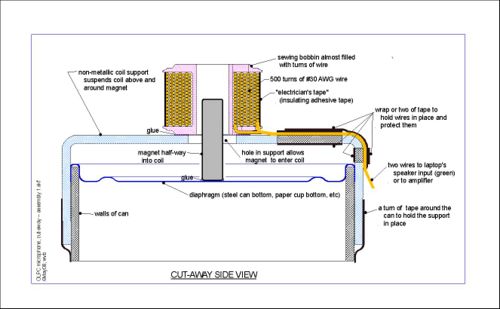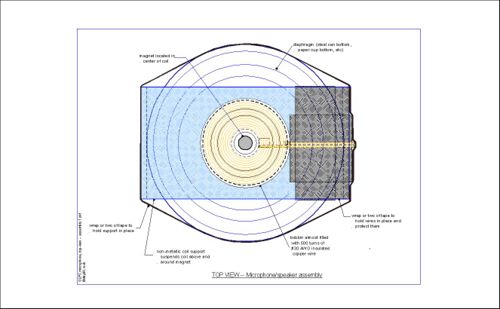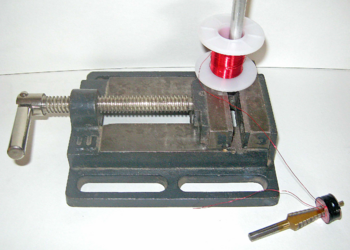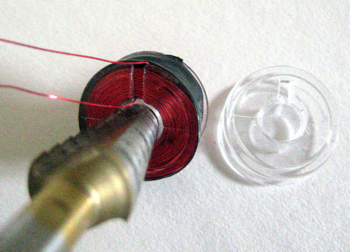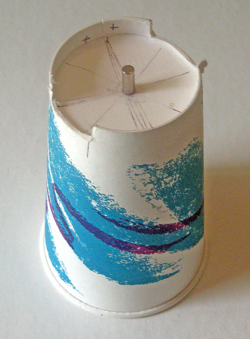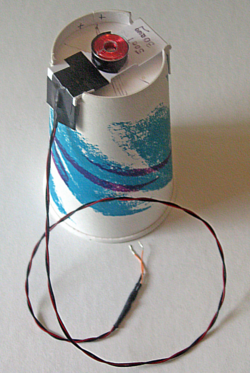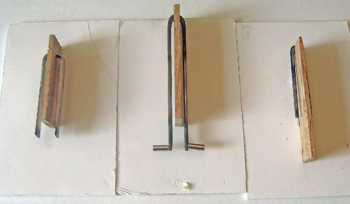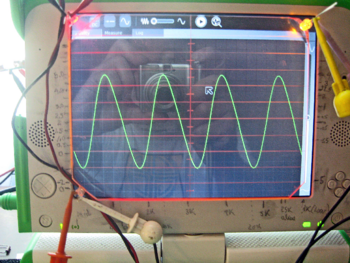Measure/Activities/Magnets and Wire: Difference between revisions
(→Build your own microphone. Build your own speaker.: twiddle with the intro) |
(→Build your own telephone: change bold-faced header to subsection) |
||
| (2 intermediate revisions by the same user not shown) | |||
| Line 13: | Line 13: | ||
For someone who has never seen this demonstration, the following will be a real surprise – that something so simple/primitive can do so much. |
For someone who has never seen this demonstration, the following will be a real surprise – that something so simple/primitive can do so much. |
||
''' |
'''Teaching points''': |
||
:1 Physics of electric induction – A ''changing'' magnetic field creates a changing electric field (voltage) that can move electrons in the vicinity. In the case of a copper wire the electrons are floating around loose inside the wire (like a gas of electrons wandering among their copper atoms) and the changing magnetic field causes them to move. (Why? Because of relativity. The effect is velocity-dependent: the faster the magnetic field changes, the larger the induced voltage.) Moreover the effect works in reverse: If electrons are moving they create a magnetic field relative to a stationary object, e.g. the wire itself. If they change their speed they cause a ''changing'' magnetic field in their vicinity -- this is the principle of the speaker. |
:1 Physics of electric induction – A ''changing'' magnetic field creates a changing electric field (voltage) that can move electrons in the vicinity. In the case of a copper wire the electrons are floating around loose inside the wire (like a gas of electrons wandering among their copper atoms) and the changing magnetic field causes them to move. (Why? Because of relativity. The effect is velocity-dependent: the faster the magnetic field changes, the larger the induced voltage.) Moreover the effect works in reverse: If electrons are moving they create a magnetic field relative to a stationary object, e.g. the wire itself. If they change their speed they cause a ''changing'' magnetic field in their vicinity -- this is the principle of the speaker. |
||
| Line 70: | Line 70: | ||
'''Assembly instructions''': |
'''Assembly instructions''': |
||
[[Image:OLPC vise and coil 1.png|thumbnail|350 px|right|It helps to put the spool of wire on a stick and hold the stick in a vise; the coil is being held in a mandrel, in this case a "step drill". But any tapered stick (e.g. a wooden pencil tapered to less than 0.25 inch) will work |
[[Image:OLPC vise and coil 1.png|thumbnail|350 px|right|It helps to put the spool of wire on a stick and hold the stick in a vise; the coil is being held in a mandrel, in this case a "step drill". But any tapered stick (e.g. a wooden pencil tapered to less than 0.25 inch) will work.]] |
||
[[Image:OLPC guitar probe coil 3b.png|thumbnail|350 px|right|Closeup of the finished coil.]] |
[[Image:OLPC guitar probe coil 3b.png|thumbnail|350 px|right|Closeup of the finished coil. On the right is an unmodified bobbin as it comes from the package. To allow the first (inner-most) turn to escape along the radius of the bobbin, lengthen one of the slots all the way out to the edge.]] |
||
[[Image:OLPC cup and magnet 1.png|thumbnail|250 px|left|A "hot drink" Sweetheart (brand) cup with the 1/2 inch long, 0.187 inch diameter magnet glued to its center -- the trick is to get the magnet in the center of the coil (Teaching point: what is a good way to find the center? -- I didn't do too well at this task myself.)]] |
[[Image:OLPC cup and magnet 1.png|thumbnail|250 px|left|A "hot drink" Sweetheart (brand) cup with the 1/2 inch long, 0.187 inch diameter magnet glued to its center -- the trick is to get the magnet in the center of the coil (Teaching point: what is a good way to find the center? -- I didn't do too well at this task myself.)]] |
||
| Line 92: | Line 92: | ||
=== Build your own telephone === |
=== Build your own telephone === |
||
[[Image:OLPC wire-vibration detector -- cut-away 1.JPG| |
[[Image:OLPC wire-vibration detector -- cut-away 1.JPG|500 px|thumbnail|right|This "probe" -- the coil of wire with a magnet in its center -- allows you to see the vibration of a steel wire of e.g. a guitar. Together with a second, identical, "speaker" coil and an amplifier you can explore the notion of feedback -- you can make the wire (or tuning fork -- see below) vibrate all on its own.]] |
||
[[Image:OLPC vibrating-wire amp -- schematic 1.JPG| |
[[Image:OLPC vibrating-wire amp -- schematic 1.JPG|500 px|thumbnail|right|A tentative schematic of a 1000:1 amplifier. The vibrating-wire experiment is shown here; the same amplifier is used for the telephone experiment. (Click on the drawing to make it bigger. Will have to redraw a bit to get better resolution...) A single opamp 1000:1 amplifier built with 100 ohm resistors and 100K resistors (matched to 0.1%) will also work. But I'm finding that two 50:1 amplifiers (each made with 2.00K and 100K (matched to 0.1%) resistors) works better and is less fussy (this is because of what is called the amplfiers' "gain-bandwidth product"). With this much total gain -- 50 x 50 = 2500 -- errors caused by the opamps' "input offset" becomes a serious factor in the design -- hence the use of an expensive LT1013 or LT1413 dual opamp.]] |
||
This is a fussier experiment. A one-way telephone requires two of the microphones described above plus a high-gain audio amplifier in between. One successful design I've tried for the amplifier follows the same design-concept as the "oscilloscope probe" described in [[Measure/Projects]], but with ''two'' differential amplifiers. A balance must be struck in the design between a need for total high gain (e.g. between 1000 and 2500), errors caused by input-offset and gain-bandwidth, cost, complexity etc. The circuit shown does four things: (1) amplify the input, (2) move the "zero" of the signal "up" to 1.17 volts, thus placing the signal-trace in the center of the laptop's screen, (3) prove capable of driving into the laptop's 2000 ohm (2K) input impedance, (4) prove capable of driving the speaker coil with enough current. |
This is a fussier experiment. A one-way telephone requires two of the microphones described above plus a high-gain audio amplifier in between. One successful design I've tried for the amplifier follows the same design-concept as the "oscilloscope probe" described in [[Measure/Projects]], but with ''two'' differential amplifiers. A balance must be struck in the design between a need for total high gain (e.g. between 1000 and 2500), errors caused by input-offset and gain-bandwidth, cost, complexity etc. The circuit shown does four things: (1) amplify the input, (2) move the "zero" of the signal "up" to 1.17 volts, thus placing the signal-trace in the center of the laptop's screen, (3) prove capable of driving into the laptop's 2000 ohm (2K) input impedance, (4) prove capable of driving the speaker coil with enough current. |
||
| Line 102: | Line 102: | ||
This "telephone" amplifier can also double as an amplifier for a signal generator, so the kids can see the signals on the screen as they hear the sound. |
This "telephone" amplifier can also double as an amplifier for a signal generator, so the kids can see the signals on the screen as they hear the sound. |
||
=== Vibrating wires: === |
|||
The amplifier permits a couple of spectacular teaching points. If we put the (1/2" long) magnet in the center of the coil, we can use the coil+magnet as a "probe" or "pick-up" to explore vibrating wires. |
The amplifier permits a couple of spectacular teaching points. If we put the (1/2" long) magnet in the center of the coil, we can use the coil+magnet as a "probe" or "pick-up" to explore vibrating wires. |
||
| Line 133: | Line 133: | ||
[This experiment will need to be fleshed out. The jist is this: Clamp one end of a steel wire in a vise and hang the other end over the edge of a table with the wire running over e.g. a rod or pulley; attach a weight to the other end of the wire, e.g. a 5 kg (10 lb) weight. Thus the wire is being stretched with 5 kg of force. Now, rig up the wire oscillator and measure its frequency. Then double the weight, halve the weight, etc and see what the frequency is doing with the changes in weight.] |
[This experiment will need to be fleshed out. The jist is this: Clamp one end of a steel wire in a vise and hang the other end over the edge of a table with the wire running over e.g. a rod or pulley; attach a weight to the other end of the wire, e.g. a 5 kg (10 lb) weight. Thus the wire is being stretched with 5 kg of force. Now, rig up the wire oscillator and measure its frequency. Then double the weight, halve the weight, etc and see what the frequency is doing with the changes in weight.] |
||
=== Build your own tuning forks and a tuning-fork oscillator''' === |
|||
'''Teaching point -- Tuning forks, oscillator and resonance''': |
|||
[[Image:OLPC tuning forks 1.png|thumbnail| |
[[Image:OLPC tuning forks 1.png|thumbnail|350px|left|The center fork has the 1/2 inch long x 0.187 inch diameter magnets sticking to its tines.]] |
||
[[Image:OLPC vibrating tuning fork 1.png|thumbnail|350px|right|The blurred tines of the fork and the separation of the coils from the magnets shows the extent of the oscillation. Here the smaller 1/2 inch long x 0.156 inch diameter magnets are sticking to the tines. The breadboard circuit on the right is both the pickup coil's amplifier (100 gain) and the drive-coil's driver (uses a 2N2222A transistor) plus, for the laptop's microphone input, a 1:1 DC buffer-amplifier with 1.18 volt offset to put the trace's "zero" roughly in the center of the screen.]] |
|||
[[Image:OLPC tuning fork oscillation on screen 1.png|thumbnail|350px|right|With the right-hand slider in the center position, the 1:1 calibration of the lines of the graticule is 0.025 volts (25 millivolts) per division. At approximately 6 divisions the sinewave signal is approximately 0.15 volts peak-to-peak.]] |
|||
This experiment is easier to do than the wire-oscillator. You will need a 50:1 amplifier, two magnets, and two microphone/speaker coils. But you have to build a tuning fork if you can't find one -- steel is preferred because you can just put a magnet on each tine of the fork (at the end), then position the coils so that the magnets are free to move just inside the coils. |
This experiment is easier to do than the wire-oscillator. You will need a 50:1 amplifier, two magnets, and two microphone/speaker coils. But you have to build a tuning fork if you can't find one -- steel is preferred because you can just put a magnet on each tine of the fork (at the end), then position the coils so that the magnets are free to move just inside the coils. |
||
| Line 140: | Line 144: | ||
I built a couple different types, one out of a 6-inch strip of 0.375 inch wide x 0.062 inch thick mild steel, and two out of 0.125 inch diameter steel rod (all this stuff came from a hardware store e.g. Home Depot, but I had to cut the strip out of a plate with a saw). |
I built a couple different types, one out of a 6-inch strip of 0.375 inch wide x 0.062 inch thick mild steel, and two out of 0.125 inch diameter steel rod (all this stuff came from a hardware store e.g. Home Depot, but I had to cut the strip out of a plate with a saw). |
||
The better results occurred with the steel rod. I bent the rod by first heating the place where I wanted to bend it over a gas-stove's flame and then when red-hot it bent pretty easily. I waited for the rod to cool ( |
'''To build a tuning fork:''' The better results occurred with the steel rod. I bent the rod by first heating the place where I wanted to bend it over a gas-stove's flame and then when red-hot it bent pretty easily. I waited for the rod to cool (heating it and slowly cooling it tempers the metal -- but the next step can be done when the rod's hot, too). I then pretended I was a blacksmith and pounded the bend on a little anvil so the bend flattened out; I was also able to shape the bent rod into a decent U. I went through this heating/pounding a few times to get the bend nice and flat and the fork into a decent U-shape. Then I cut both tines of the U to the same length (approximately -- I used a Dremel diamond disk -- less than $10 -- to cut the tines) and lastly I sanded them as closely as I could to the same length on a Dremel disk sander. To make some "flats" for the magnets at the ends of the tines, I just sanded the end 1/4 inch or so down about halfway. This whole process took about 10-15 minutes, tops. |
||
| ⚫ | Now comes the part that gave me a half-day's trouble until I figured it out. The idea is to hold the tuning fork in the center of the bend and mount the fork+holder on something that can hold the pickup and drive coils. I used foam-core "board" but I'd recommend something stiffer -- a wood sounding-box would be really nifty. What I figured out was: cut a strip of hard wood (e.g. oak) about 0.125 - 0.150 inch wide x 1.0 inch tall by 3-4 inches long. In one end, about 1/2 inch up and about 1/2 deep, cut a slot the width of the place where you hammered down the U-end of the fork. Shove this U-end into the slot "backwards" so the board is now running between the tines. This both acts as a stiffener and a sound-coupler into a sounding-box, if available. I used superglue to glue the fork into slot, then glued the wood+fork on the foam-core "board". |
||
| ⚫ | Stick a magnet on the end of either tine, so they're sticking outward -- if you use steel there's no need to glue them, they'll stay in position. Then position a pickup coil near one magnet and the drive coil near the other magnet (same idea as the microphone and magnet) and hook this up to a 1:100 ''amplifier'' (not an attenuator). If the oscillation doesn't start right up, tweak the tines, and then if nothing happens either flip the wires of one coil or flip one of the magnets around to reverse its exposed pole. |
||
I had no problem getting oscillation -- the two bent-rod tuning forks went wild. If everything is in proper position (e.g. the magnets are not rubbing on the coil) the 500-turn coils with the recommended magnets and a 1:100 amplifier+driver is working (test it by tweaking the tines and watching the picked-up signal on the screen). |
|||
| ⚫ | |||
'''Experiments:''' |
|||
* 1) If you have two magnets of different sizes -- e.g. each 1/2 inch long x 0.10, 0.125, 0.156, 0.187, 0.250 diameter -- how does the frequency change with the weight of the magnets on its tines? |
|||
* 2) What happens when you move both magnets toward the U, i.e. shorten the distance from the U to the magnets? |
|||
: This works best with a longer tuning fork. The longer fork in the photos is approximately 4.5 inches long (11.5 cm) and made from 0.125 inch diameter steel. Also, the heavier the magnet, the more mass is concentrated in the magnet, so the frequency change will be more noticeable. Also, if you file/sand flats on the outer edges of the tines (not too deep), the magnets will have flats to help them stay in position. |
|||
* 3) You will observe that the shorter a fork's tines the more difficult it is to get the fork to oscillate. Why? |
|||
| ⚫ | Now comes the part that gave me a half-day's trouble until I figured it out. The idea is to hold the tuning fork in the center of the bend and mount the fork+holder on something that can hold the pickup and drive coils. |
||
| ⚫ | |||
| ⚫ | Stick a magnet on the end of either tine, so they're sticking outward -- if you use steel there's no need to glue them, they'll stay in position. Then position a pickup coil |
||
This experiment requires a signal generator with enough oomph to drive the "drive coil" -- with magnet inside for the wire, or magnet external for the tuning fork -- and a e.g. 1:100 amplifier. Put the drive-coil up to the tuning fork (or wire) and watch the amplified signal from the pick-up coil on the laptop. |
|||
| ⚫ | |||
| ⚫ | '''Resonating a wire:''' Space the two coils sufficiently apart to convince yourself that the pickup coil is simply not "seeing" the drive-coil -- i.e. place one 1/4 the wire-length from each end of the wire. Then slowly "dial in" the frequency until the pickup coil begins to really hum. This can happen at the fundamental or any of its harmonics. |
||
| ⚫ | |||
'''Resonating a tuning fork:''' Similar to the wire. You will probably not see harmonics, only the fundamental. |
|||
| ⚫ | |||
Latest revision as of 22:39, 20 May 2008
Magnets and Wire
Build your own microphone. Build your own speaker.
This is a work in progress.
The following demonstrates how a moving (thus changing) magnetic field "induces" -- causes -- electrons to move (move in wires, in these experiments). Vice versa, a changing electric field (e.g. caused by accelerating or decelerating electrons) creates a magnetic field in its vicinity. And because the loop can close, a changing magnetic field that creates a changing electric field will in turn create a changing magnetic field (principle of electromagnetic induction). These are the fundamental principles behind the electric motor, the buzzer, the electrical relay (and the telegraph), the typical audio speaker and microphone (the telephone), the inductor and transformer, and electromagnetic (radio) waves).
For someone who has never seen this demonstration, the following will be a real surprise – that something so simple/primitive can do so much.
Teaching points:
- 1 Physics of electric induction – A changing magnetic field creates a changing electric field (voltage) that can move electrons in the vicinity. In the case of a copper wire the electrons are floating around loose inside the wire (like a gas of electrons wandering among their copper atoms) and the changing magnetic field causes them to move. (Why? Because of relativity. The effect is velocity-dependent: the faster the magnetic field changes, the larger the induced voltage.) Moreover the effect works in reverse: If electrons are moving they create a magnetic field relative to a stationary object, e.g. the wire itself. If they change their speed they cause a changing magnetic field in their vicinity -- this is the principle of the speaker.
- 2 Use the microphone “backwards” as a speaker (requires a source of sine waves: the laptop itself?) I’ve designed a sine wave generator (more accurately: a voltage-to-frequency converter) that does the trick nicely. More to follow on this.
- 3 Transformer (induction from coil to coil -- best demo requires a signal generator and two coils, but the 3.5KHz signal from the laptop is a quick demo):
- Use the coil of wire (no magnet necessary) to pick up a 3.5 KHz magnetic noise from the laptop itself, and see how to determine this mysterious signal with the Frequency activity (needs calibration of the X-axis -- the proposed sine-wave generator can do this. More to follow).
- What happens when an iron (steel) rod e.g. a screwdriver shaft is placed down the centers of both cores?
- 4 With sufficient amplification (need an amplifier, perhaps) the microphone can demonstrate “seismic rumble” etc.
- 5 Acoustic resonance (of tubes of different lengths). This should be quite apparent if we can come up with a decent signal generator.
- Reflections of waves: I've seen it happen, but need to figure out how to demonstrate it.
- 6 Microphone and speaker-cones: What is the optimal shape? I.e. to give you the loudest sound out aor the best microphone (think of: the RCA dog listening to his master's voice).
- 7 "See" vibrations on the screen: Resonators and oscillators. "See" the motion of a guitar-wire. "See" the motion of the tines of tuning fork. See the motion of the tip of a knife-blade.
- 9 Build an oscillator: A tuning fork can be excited by its own motion fed back to it – the analogy of a kid on a swing. Ditto for a guitar wire (but this is a bit fussier to demonstrate).
- 8 Electromagnets: Make your own relay or telegraph? This requires a 1/4 "plug" of steel instered into the coil, and a U-shape piece of steel, too. (So does number 6, except a magnet needs to substitute for the steel core.) My first crack at this drew 1/2 amp of current and wasn't a very strong magnet. More work is required, may not be possible.
- 9 Earth's magnetic field ?? -- with a ~1000:1 amplifier I've been able to pick up stray magnetic fields (e.g. from an old Hewlett-Packard power supply) at a distance of 1-2 feet. I observed that if you move the coil (a 1000-turn coil, no core) back and forth not much happens. But if you rotate the core, the trace wiggles. Is this picking up the earth's magnetic field?
Quick description:
Glue a powerful-but-tiny cylindrical magnet end-up in the center of a steel can (paper cup, plastic cup). Locate a sewing bobbin, perhaps prep it with a longer slot, wind the bobbin with with insulated #30 AWG "magnet" wire (about 500 turns -- but any gauge that puts a couple hundred or more turns on will do). Rig up a support to hover the coil over (but not touching) the magnet + can, so that the magnet's end is about 1/2 way into the coil (learning experience here: why only 1/2 way? What happens if it is all the way in?). Strip the wire ends (use sandpaper), connect them to the microphone port and voila, you have a microphone. If you have a source of sine waves (square waves, etc) you can “drive” the coil and sound will come out the mouth of the can.
Stuff needed:
- Monaural or stereo audio plug
- Magnet about 0.187 inch diameter, 0.5 inch long. Magnet should be as strong as possible, but small enough to fit with a bit of clearance through the center-hole of the bobbin (see below). Magnet must be magnetized so that it has a north pole at one end and a south pole at the other end. Recommended part: Cyl0134 purchased from www.supermagnetman.net:
- A bit about magnets: I've purchased 4 types from www.supermagnetman.net: These are very powerful "rare-earth" magnets, far more powerful than those obtained from e.g. Radio Shack. They could cause harm if swallowed. They will damage magnetic media such as magnetic disk drives and floppy disks. All are perfect for the tuning-fork experiment.
- cyl0132 -- 0.156 inch x 0.500 inch: $0.55 each in qty of 20.
- cyl0134 -- 0.156 inch x 6 mmm:
- cyl0150 -- 0.187 inch x 0.500 inch: $0.22 each in qty of 20. Gives more output than the 0.156 diameter magnets, but is fussier to align the magnet in the coil's center-hole in the telephone microphone and speaker experiments.
- cyl0175 -- 0.250 inch x 0.500 inch: $0.50 each in qty of 20. Perfect for the guitar-string probe, it fits snuggly in the 0.250 diameter hole of the coil but can be pushed out and used for other experiments.
- Alternately: a strong ceramic disk (i.e. rather flat) magnet will work, but less well than the longer magnet that allows insertion of only one pole into the coil. I've tried the following: a steel “plug” is put into the bobbin’s center-hole. More work is required to test this out -- the results are not particularly worth the effort.
- Empty, clean steel can (“tin can”). My best luck has been with a Minute Maid, 6 oz Limeade (fruit juice) can.
- Excellent alternate: Paper drinking cup (without wax on it).
- Another alternate: Thin plastic container with a base about 2-3 inches in diameter.
- Plastic(non-metallic) sewing bobbin (class 15 or class 66 type) with 0.25 inch diameter center hole (6.2 mm hole)
- Insulated copper “magnet” wire -- recommended is #30 AWG (American Wire Gauge). The mean length of turn on the bobbin is about 1.0 inch per turn, so 500 turns comes out to about 45 feet (15 meters). 500 turns will fit on the bobbin. Alternates: #28 AWG (coarser wire -- 300 Turns will fit on the bobbin), #34 AWG (much finer wire -- 1000 turns will fit on the bobbin). The fine wire becomes hard to wind and subject to breakage.
- Adhesive tape (recommended: "electrician's tape" -- a soft, stretchable, vinyl tape with googey-adhesive ; but any tape will do)
- ”Super glue” (methyl methacrylate glue), model glue, whatever...
- A non-metallic mechanical “support” to suspend the coil of wire (wound on the bobbin) over the magnet -- I found some 0.050 inch thick polystyrene at a model store and bent it. See the instructions.
Assembly instructions:
Winding 500 turns of thin is boring, but good for manual dexterity. It helps to put the spool of (source of) wire on a "mandrel" (e.g. a pencil through the spool) so that it unwinds as you wind the bobbin. And put a "mandrel" inside the bobbin so you can handle it easier. If you break the wire, try to repair with solder, and insulate the repaired place. Strip the insulation with some fine sandpaper, then "tin" the wire with flux-core solder and then solder the two wires together. (Or start over ... keep this coil with fewer turns for experiment -- what is the relationship between the number of turns and the strength of the microphone?).
The hardest part is fabricating a "support". Use non-metallic materials, relatively stiff (wood will work fine). The goal is a support that suspends the coil above and around, but not touching, the magnet. The support should be stiff enough, so that if you put a steel “plug” (more about the plug to follow) inside the bobbin's hole, the magnet cannot pull the coil+plug down and stick to the plug.
I started with a strip of polystyrene plastic, 1 inch wide by width-of-can+2 inches long, and fabricated this into a U, as follows. First I cut out the strip with scissors: I measured off approx. 1 inch, then about 0.050 inch (bend allowance), then the width of the can, then about 0.050 inch (bend allowance) and another 1 inch of plastic . In the center of this I drilled a 3/8 inch hole (to allow the magnet to pass into the center-hole of the bobbin).
To make the bends heated a thin (0.062 diameter) metal rod) over a gas flame so it is hot enough to melt the plastic but not burn it. Then I gently pressed the rod down, lengthwise over/along, a bend-allowance mark (i.e. where I wanted to bend the plastic). The hot rod melted the plastic about ½ way through. I then quickly bent the plastic up. As it hardened the plastic welded. (Do twice to form the U). Alternately, glue together the pieces.
The second hardest part is figuring out how to protect the thin wires from breakage. I had the wires come out the bottom of the coil, then run along the plastic support so I could cover them with the electrician's tape. I then cut the wires, stripped them with sandpaper for about 1/2 inch, tinned these 1/2 inch lengths, found some flexible wire, stripped and tinned it, soldered the flexible wire to the coil's wires, and protected the two joints with heatshrink tubing.
- There is an advantage to using soft, flexible wire -- the microphone is quite sensitive, and the wires will bang into it, causing spurious noise.
Run the laptop in AC mode with the DC bias off.
Build your own telephone


This is a fussier experiment. A one-way telephone requires two of the microphones described above plus a high-gain audio amplifier in between. One successful design I've tried for the amplifier follows the same design-concept as the "oscilloscope probe" described in Measure/Projects, but with two differential amplifiers. A balance must be struck in the design between a need for total high gain (e.g. between 1000 and 2500), errors caused by input-offset and gain-bandwidth, cost, complexity etc. The circuit shown does four things: (1) amplify the input, (2) move the "zero" of the signal "up" to 1.17 volts, thus placing the signal-trace in the center of the laptop's screen, (3) prove capable of driving into the laptop's 2000 ohm (2K) input impedance, (4) prove capable of driving the speaker coil with enough current.
The sound out isn't spectacular by any means, but it makes the point.
This "telephone" amplifier can also double as an amplifier for a signal generator, so the kids can see the signals on the screen as they hear the sound.
Vibrating wires:
The amplifier permits a couple of spectacular teaching points. If we put the (1/2" long) magnet in the center of the coil, we can use the coil+magnet as a "probe" or "pick-up" to explore vibrating wires.
- For this experiment you won't need an amplifier. Put the laptop in AC mode, DC bias off. You will need just the coil of wire (500 turns of 30 AWG wire), a (4 mm (0.156 inch) x 1/2 inch-long) "rare-earth" magnet, a strip of paper, and a stretched steel wire of a string-instrument.
- I am currently researching what will happen with 5 and 6.2 mm magnets; also whether or not a U of steel bent around the coil, with a hole drilled in it for the magnet, will make this probe better. I believe the answer is yes...
For this experiment we proceed as follows:
- 1 Cut a strip of paper about 1 cm wide, about 25 cm long, and roll the magnet up inside the strip. It helps to tape or paste the magnet to one end of the strip and then roll it up. Then trim the strip's length away until the magent+paper "slug" fits into the coil snuggly.
- 2 To keep the magnet from being attracted to the wire and pulling out of the coil, put tape over the end of the magnet+coil that will be near the wire. The magnets are strong enough to actually stretch the wire and stick to it.
- 3 Find a stretched steel wire -- e.g. a guitar (I happened to have a dulcimer. This instrument turned out to be fortuitous because I could modify the coil's U-shapped support to suspend the coil+magnet above the wire 1-2 millimeters, and then slide the coil+magnet+support along the neck (which is attached to the sounding board) of the dulcimer. Anyway ... that's the notion I'm after here.)
- 4 Put the microphone coil+magnet "probe" up close to the wire (less than 0.1 inch/2.5 mm) and pluck the wire. Given the recommended magnet (0.5 inch long, 0.156 inch diameter rare-earth magnet) you should see sine wave(s) -- the fundamental and harmonics -- of the wire.
- Put the laptop into AC with the DC bias off, and a fair amount of "gain" (slider on the right side up 3/4 of the way). (A weaker alnico magnet may require the slider up further, or the amplification of the "telephone").
Teaching point -- wire oscillator, force and pressure measurements:
The wire-version of this experiment is fussy; the tuning-fork version is less fussy. If a digital counter is available (it is in some DVMs) the wire-version can be used to meassure force.
Preliminary experiments show that it requires a 2500:1 "telephone" amplifer and two guitar-pickup coils, both with magnets inside them (e.g. the 0.25 inch diameter magnets). One coil acts is the "microphone-pickup", the other the "speaker-driver". I built a fancy version pick/driver version with the magnet pressfit+glued in the center of a bent strip of mild steel -- this design is adopted from vibrating wire force-gauge instrumentation.
Use the U-shaped coil supports, if they are long enough, to suspend each coil+magnet over the wire you want to vibrate (e.g. the guitar wire) -- it must not touch the wire, but should be a millimeter or two away from the wire.
- As noted, this experient is fussy to perform. Adequate amplification is required (I'm using about 2500:1 amplification; at 500:1 to 1000:1 the wire will vibrate, but only with some tweaking), a pickup coil with 1000 turns and the driver coil with 500 turns (I don't believe this matters too much). What is important is having powerful magnets and having these coils+magnets each close to the wire, but not actually touching it, getting the "phasing" of the coils right for either the fundamental or the harmonic, and getting the two coils placed correctly on the wire.
When you bring the two coils closer together, the trace on the laptop may "go nuts". This is the result of feedback -- the same thing that causes a microphone+amplifier+speakers in a concert hall to "go nuts" and squeel. In our case, if you put one coil 1/4 of the way from an end of the wire and the other coil 1/4 from the other end, you will excite the first harmonic (twice the frequency of the fundamental). To excite the fundamental, flip one of the coil's wires where they go into the amplifier. Now when close together they will not "go nuts", but when placed relatively close together in the center of the wire, the wire should vibrate in the fundamental mode.
Teaching point -- Measure force (weight) with a vibrating wire::
[This experiment will need to be fleshed out. The jist is this: Clamp one end of a steel wire in a vise and hang the other end over the edge of a table with the wire running over e.g. a rod or pulley; attach a weight to the other end of the wire, e.g. a 5 kg (10 lb) weight. Thus the wire is being stretched with 5 kg of force. Now, rig up the wire oscillator and measure its frequency. Then double the weight, halve the weight, etc and see what the frequency is doing with the changes in weight.]
Build your own tuning forks and a tuning-fork oscillator
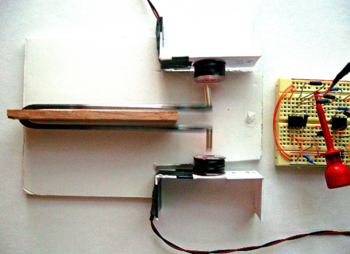
This experiment is easier to do than the wire-oscillator. You will need a 50:1 amplifier, two magnets, and two microphone/speaker coils. But you have to build a tuning fork if you can't find one -- steel is preferred because you can just put a magnet on each tine of the fork (at the end), then position the coils so that the magnets are free to move just inside the coils.
I built a couple different types, one out of a 6-inch strip of 0.375 inch wide x 0.062 inch thick mild steel, and two out of 0.125 inch diameter steel rod (all this stuff came from a hardware store e.g. Home Depot, but I had to cut the strip out of a plate with a saw).
To build a tuning fork: The better results occurred with the steel rod. I bent the rod by first heating the place where I wanted to bend it over a gas-stove's flame and then when red-hot it bent pretty easily. I waited for the rod to cool (heating it and slowly cooling it tempers the metal -- but the next step can be done when the rod's hot, too). I then pretended I was a blacksmith and pounded the bend on a little anvil so the bend flattened out; I was also able to shape the bent rod into a decent U. I went through this heating/pounding a few times to get the bend nice and flat and the fork into a decent U-shape. Then I cut both tines of the U to the same length (approximately -- I used a Dremel diamond disk -- less than $10 -- to cut the tines) and lastly I sanded them as closely as I could to the same length on a Dremel disk sander. To make some "flats" for the magnets at the ends of the tines, I just sanded the end 1/4 inch or so down about halfway. This whole process took about 10-15 minutes, tops.
Now comes the part that gave me a half-day's trouble until I figured it out. The idea is to hold the tuning fork in the center of the bend and mount the fork+holder on something that can hold the pickup and drive coils. I used foam-core "board" but I'd recommend something stiffer -- a wood sounding-box would be really nifty. What I figured out was: cut a strip of hard wood (e.g. oak) about 0.125 - 0.150 inch wide x 1.0 inch tall by 3-4 inches long. In one end, about 1/2 inch up and about 1/2 deep, cut a slot the width of the place where you hammered down the U-end of the fork. Shove this U-end into the slot "backwards" so the board is now running between the tines. This both acts as a stiffener and a sound-coupler into a sounding-box, if available. I used superglue to glue the fork into slot, then glued the wood+fork on the foam-core "board".
Stick a magnet on the end of either tine, so they're sticking outward -- if you use steel there's no need to glue them, they'll stay in position. Then position a pickup coil near one magnet and the drive coil near the other magnet (same idea as the microphone and magnet) and hook this up to a 1:100 amplifier (not an attenuator). If the oscillation doesn't start right up, tweak the tines, and then if nothing happens either flip the wires of one coil or flip one of the magnets around to reverse its exposed pole.
I had no problem getting oscillation -- the two bent-rod tuning forks went wild. If everything is in proper position (e.g. the magnets are not rubbing on the coil) the 500-turn coils with the recommended magnets and a 1:100 amplifier+driver is working (test it by tweaking the tines and watching the picked-up signal on the screen).
- To see the sine wave motion of the tuning fork, you will need either a DC amplifier e.g. 1:1 with 1.18 volt offset for DC input, or you can put the laptop on AC, no bias, and connect directly to where the wires from the pickup coil go into the amplifer.
Experiments:
- 1) If you have two magnets of different sizes -- e.g. each 1/2 inch long x 0.10, 0.125, 0.156, 0.187, 0.250 diameter -- how does the frequency change with the weight of the magnets on its tines?
- 2) What happens when you move both magnets toward the U, i.e. shorten the distance from the U to the magnets?
- This works best with a longer tuning fork. The longer fork in the photos is approximately 4.5 inches long (11.5 cm) and made from 0.125 inch diameter steel. Also, the heavier the magnet, the more mass is concentrated in the magnet, so the frequency change will be more noticeable. Also, if you file/sand flats on the outer edges of the tines (not too deep), the magnets will have flats to help them stay in position.
- 3) You will observe that the shorter a fork's tines the more difficult it is to get the fork to oscillate. Why?
Teaching point: Resonance
This experiment requires a signal generator with enough oomph to drive the "drive coil" -- with magnet inside for the wire, or magnet external for the tuning fork -- and a e.g. 1:100 amplifier. Put the drive-coil up to the tuning fork (or wire) and watch the amplified signal from the pick-up coil on the laptop.
Resonating a wire: Space the two coils sufficiently apart to convince yourself that the pickup coil is simply not "seeing" the drive-coil -- i.e. place one 1/4 the wire-length from each end of the wire. Then slowly "dial in" the frequency until the pickup coil begins to really hum. This can happen at the fundamental or any of its harmonics.
Resonating a tuning fork: Similar to the wire. You will probably not see harmonics, only the fundamental.
